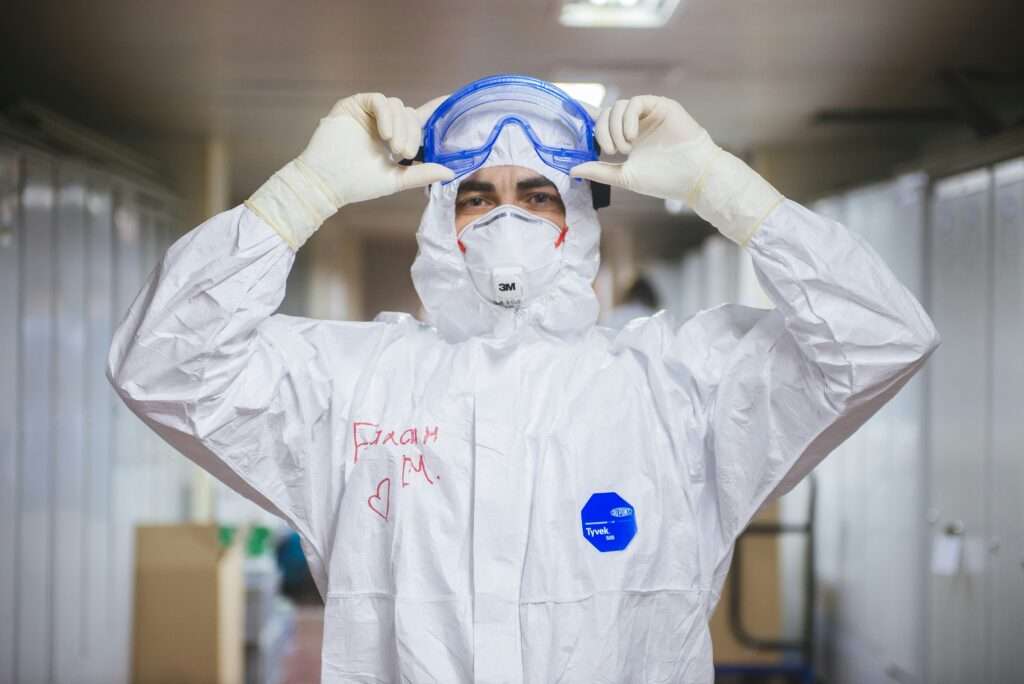Coronavirus disease (COVID-19) was classified as a pandemic on 11th March 2020, five years ago (WHO). Caused by the SARS-CoV-2 virus, this global healthcare crisis has resulted in tens of millions of deaths worldwide (Mathieu et al., 2020). COVID-19 also resulted in struggling health systems worldwide. Subsequent waves of the disease significantly impacted health service delivery, healthcare workforce, facility utilisation and medical supply management. In low-resource settings, the crisis deepened the already overburdened health systems (Menendez, 2020) (Haileamlak A, 2021).

Source: Freepik
Essential services in the COVID-19 pandemic
As COVID-19 cases surged worldwide, health systems under immense pressure faced disruptions in essential services and an increased risk of preventable diseases. To address this, the World Health Organisation (WHO) issued rapid guidelines urging countries to balance the response to COVID-19 while maintaining critical healthcare functions to prevent complications and even death owing to lack of attention. It emphasised countries should prioritise areas based on healthcare capacity and local disease burden to ensure continuity of care. Some high-priority areas included reproductive, maternal, and child health, immunisations, management of chronic conditions (including mental health), critical inpatient therapies, and auxiliary services like blood banks, labs, and diagnostic imaging.
Impact of COVID-19 on Hospitals
The stressors of COVID-19 and its associated surgeries led to longer patient wait times or postponement of other scheduled surgeries or procedures (Collyer, 2022). This led to patients seeking care later, in the advanced stages of their disease (Metersky, 2024) (Glance, 2023). The Global Pulse survey conducted by the WHO indicated a large disruption in cancer care in 2021 worldwide. It reported that disruption in the care between screening and treatment was between 5-50%. Conditions like Acute Myocardial Infarction (AMI) saw a decrease in hospitalisation. Moreover, studies observed an increase in fatalities and complications from heart conditions. At the same time, there was a decrease in treatment intervention during this period (De Rosa, 2020) (Garcia, 2020). Additionally, the deferral of elective procedures also meant a reduced income for the hospitals (Metersky, 2024).
The COVID-19 pandemic also led shortage of personal protective equipment (PPE), especially during the early waves. The hospitals struggled to protect their staff as they cared for the infected patients. Additionally, there was an increasing shift towards telemedicine services. This became an important means of delivering healthcare without the risk of virus transmission. It helped ensure continuous care for non-essential medical issues, chronic conditions, and mental health support through video calls, phone calls, and messaging apps.

Source: Unsplash
The Impact of COVID-19 on Healthcare Workers
Healthcare workers were one of the most affected populations during the pandemic. The WHO estimates that COVID-19 infected about 1 in 10 healthcare providers worldwide. Healthcare workers were at the frontline during COVID-19 and often faced increased workloads, heightened stress, and physical and emotional exhaustion. Moreover, the uncertainty of the COVID-19 crisis frequently led to them being overwhelmed by the increasing number of patients, lack of resources, and fear of exposure to the virus. Studies have reported that the relentless nature of their work and the constant fear of exposure to the virus led to many mental health challenges in the healthcare workforce. This included anxiety, depression, and post-traumatic stress disorder. Coupled with this, the emotional toll of taking care of critically ill patients and the associated grief can lead to burnout (Gupta, 2021) (Shanfelt, 2020).
Healthcare providers caring for patients with COVID-19 also faced stigmatisation during the pandemic. There have been instances of healthcare providers being denied access to public transport or even being subjected to assault (Bagchi, 2020) (Alhouri, 2023). Despite these challenges, pandemic-led innovations of remote consultations, increased integration of mental health support for workers, wellness programs and other services were introduced to address the emotional toll on workers (Byrne, 2023).
Post COVID-19: Where do we stand now?
It’s been 5 years since the Covid 19 pandemic and the world has already made strides in recovery. While we have done much in the aftermath of the pandemic, we still face a complex evolving landscape. Some of the key areas are:
Long COVID
Long COVID is a set of persistent symptoms that last for weeks or months after one has fully recovered from the acute phase of a COVID-19 infection. Some of these symptoms may involve fatigue, shortness of breath, brain fog, muscle aches, headache, and sleep disorders (Mayo Clinic, 2024). The estimated prevalence of long COVID is approximately 6–7% in adults and approximately 1% in children. More than 400 million people worldwide have had long COVID. Long COVID is possibly contributing to a loss of 1% of the globe’s gross domestic product (Aly, 2024).
Technology and Innovation
Telemedicine is defined as the utilisation of electronic information and communications technology to support and deliver health care when patients are separated by distance (Field, 1996). The shift to telemedicine and virtual consultations during the pandemic has unlocked new pathways for healthcare delivery. These innovations have enabled continued treatment for non-COVID patients, particularly for chronic illnesses, mental health care, and regular check-ups. However, it is important to note that the use of telemedicine is not proportionate across all population groups (Omboni,2022).
mRNA Vaccines
Scientists were able to successfully develop and deploy mRNA vaccines to combat COVID-19. Researchers are now working to explore their uses in other diseases influenza, and cancer. The technology’s flexibility and its ability to be developed rapidly, provide an advantage. This opens up new avenues for innovative treatments (May 2021).
Mental Health
The pandemic has resulted in a significant increase in anxiety, depression, and other mental health conditions. Social isolation, job losses, and fear of illness also amplifies these issues. In the aftermath of COVID-19, mental health care and support have been brought to the forefront. Moreover, there is an urgent need to prioritize mental health alongside physical health (WHO, 2022). (WHO,2022).
Global Solidarity for Health Systems Strengthening
The WHO‘s appeal for global solidarity calls for nations to collaborate, share resources and knowledge, and concentrate on strengthening global health systems. The pandemic has highlighted the global interdependence between health systems such that problems in one country impact others. An example of this would be in the development of vaccines for COVID-19.
Call to Action: Achieving SDG Goals in the Post-COVID Era
The COVID-19 pandemic has brought to focus the vulnerability of health systems globally. It also allows us to learn from mistakes and progress towards the United Nations’ Sustainable Development Goals (SDGs)
SDG3: Good Health and Well-Being
SDG3 aims to ensure healthy lives and well-being for all. In the aftermath of the pandemic, it is critical to put the health and well-being of everyone first, including the healthcare professionals, who have carried the greatest burden of the crisis.
Health Systems Strengthening and Primary Healthcare: COVID-19 has put health systems across the globe to the test, highlighting the need for increased healthcare spending by countries. Moreover, it highlights the need for a stronger healthcare infrastructure. Many healthcare systems were already struggling before the pandemic. The UK’s National Health Service (NHS) was already grappling with understaffing and a shortage of beds, which further burdened the system during the crisis (British Medical Association, 2024).
Investment in primary healthcare is important, as a well-established and robust primary healthcare system is essential for disease prevention, preparedness, response, and recovery. It is also necessary to have measures in place that ensure the well-being of healthcare workers, not only to protect their mental health but also to enable them to continue delivering high-quality care.
SDG10: Reducing Inequalities
SDG10 focuses on reducing inequalities in all forms whether race, gender, income, ethnicity, disability, or access to basic services. While COVID-19 affected everyone, its impact was disproportionate across communities and populations. Measures like social distancing and isolation amplified existing race, gender, income, ethnicity, and other socioeconomic disparities (Sierra, 2023).
Addressing Healthcare Inequalities: Vulnerable populations often face barriers to accessing healthcare, including COVID-19 testing, treatment, and vaccination. In many countries, these groups were also less likely to have access to the necessary protective measures, increasing their risk of infection (Sierra, 2023). Closing these gaps is essential to build future health system resilience and achieve SDG10. Governments can adopt measures like improving social safety nets, access to education, employment opportunities, and health services for vulnerable populations. This can help overcome these healthcare disparities.
A Thrivable Framework
The THRIVE Framework is a holistic regenerative model that helps assess and ensure thrivability. It goes beyond sustainability and ensures that health systems are resilient, adaptive, and capable of thriving. The framework integrates the 12 Foundational Focus Factors (FFFs) to tackle the global challenges. Applying the THRIVE Framework in the context of health systems can make them stronger, equitable, and future-proof.
Systems Thinking and Complex Wicked Problem: A Systems Thinking approach considers health systems as interconnected with economic, social, and environmental factors. COVID-19 demonstrated the interconnectedness between healthcare, socio-economic factors, supply chains, the environment, etc. Complex Wicked Problems like future pandemic preparedness require integrated, cross-sectoral solutions as opposed to isolated strategies.
Finite Resources and Strong Sustainability: The pandemic revealed the constraints of Finite Resources, such as hospital beds, medical equipment, and healthcare professionals. The Strong Sustainability principle focuses on ensuring the management of resources for long-term use to avoid future crises.
Context-Based Metrics & Science-Based Targets: The health system must be context-specific, Science-Based, and not a one-size-fits-all solution. During the pandemic, low-resource settings were disproportionately affected by pre-existing vulnerabilities. Context-Based Metrics in the THRIVE Framework ensure that policies and interventions are adapted to local disease burden, workforce capacity, and healthcare access, so they can respond more effectively.
Values-Based Innovation & Multi-Capital Approach: New innovations and technology were introduced during COVID-19. However, access to these was an issue. A Values-Based Innovation approach ensures technology solutions are equity-enabled, accessible, and ethical. Moreover, the Multi-Capital Approach that places value on social, human, and environmental capital as much as financial capital is also vital to ensure equitable healthcare provision among both urban and rural populations.
Conclusion
To attain the Sustainable Development Goals, it is necessary to have an integrated and holistic approach to public health systems. Additionally, such an approach should respond both to short-term health issues and long-term sustainability. By incorporating the Foundational Focus Factors (FFFs), health systems can be transformed from managing a crisis to being resilient. This will enable societies to more effectively prepare for and weather future challenges. At the same time, global cooperation is essential in promoting fair access to health care and addressing the needs of all communities across the globe.
THRIVE Project empowers individuals and communities through research, education, and advocacy with solutions that lead to a more resilient earth. Please visit the website to access a wealth of resources including blogs, webinars, and whitepapers, and learn more about how businesses and communities embrace thrivability. Subscribe to our monthly newsletter here and follow us on LinkedIn to stay updated on the latest news.























